Dark living rooms aren’t just a trend – they’re a bold statement that transforms your space into a sophisticated sanctuary. We’ve discovered that embracing darker hues creates an intimate atmosphere that’s both dramatic and surprisingly cozy.
Many homeowners shy away from dark colors, fearing they’ll make rooms feel smaller or gloomy. But we’re here to show you how deep charcoals, rich navies, and moody blacks can actually make your living room feel more luxurious and inviting than ever before. The secret lies in understanding how to balance these darker tones with the right lighting, textures, and accent pieces.
Whether you’re working with a spacious open-concept area or a compact living room, we’ll guide you through stunning dark living room ideas that’ll completely transform your space. From paint colors that add depth to furniture choices that create visual interest, you’re about to discover why going dark might be the brightest decision you’ll make for your home.
Embrace Deep Jewel Tones for Sophisticated Drama
Jewel tones offer the perfect solution for creating depth without overwhelming your space. These rich colors provide an elegant alternative to traditional black and charcoal schemes.
Rich Emerald Green Accent Walls
Emerald green walls create stunning focal points that instantly elevate your living room’s sophistication level. We recommend painting one statement wall behind your sofa or fireplace to anchor the room without making it feel closed in. This vibrant shade pairs beautifully with brass fixtures and warm wood tones, creating a luxurious forest retreat vibe.
Layer different shades of green through accessories like throw pillows, artwork, and plants to add dimensional interest. Deep hunter green pairs with lighter sage accents, while metallic gold frames and copper planters enhance the natural richness. The key lies in balancing the intensity with neutral elements like cream curtains or beige area rugs.
Luxurious Sapphire Blue Furniture Pieces
Sapphire blue sofas serve as commanding centerpieces that transform ordinary living rooms into elegant spaces. We suggest choosing velvet or leather upholstery in this deep shade to maximize the luxurious effect. Navy sectionals work particularly well in larger rooms, while sapphire accent chairs add drama to smaller spaces.
Complement blue furniture with warm metallic accents like bronze table lamps and gold picture frames to prevent the space from feeling cold. Cream throw blankets and ivory pillows soften the intensity while maintaining the sophisticated atmosphere. Consider incorporating different blue tones through ottoman storage pieces and side tables for a cohesive color story.
Dramatic Burgundy Velvet Upholstery
Burgundy velvet chairs create instant drama that rivals any high end hotel lobby aesthetic. We love how this deep wine color catches light differently throughout the day, shifting from rich plum to warm maroon depending on your lighting setup. Position burgundy pieces near windows or under pendant lights to showcase the fabric’s natural luster.
Mix burgundy with complementary jewel tones like deep teal throw pillows or emerald side tables for a truly sophisticated palette. Brass nailhead trim and wooden legs ground these statement pieces while maintaining their elegant appeal. The texture of velvet adds tactile luxury that makes guests want to sink into your living room’s inviting atmosphere.
Layer Different Textures to Add Visual Interest
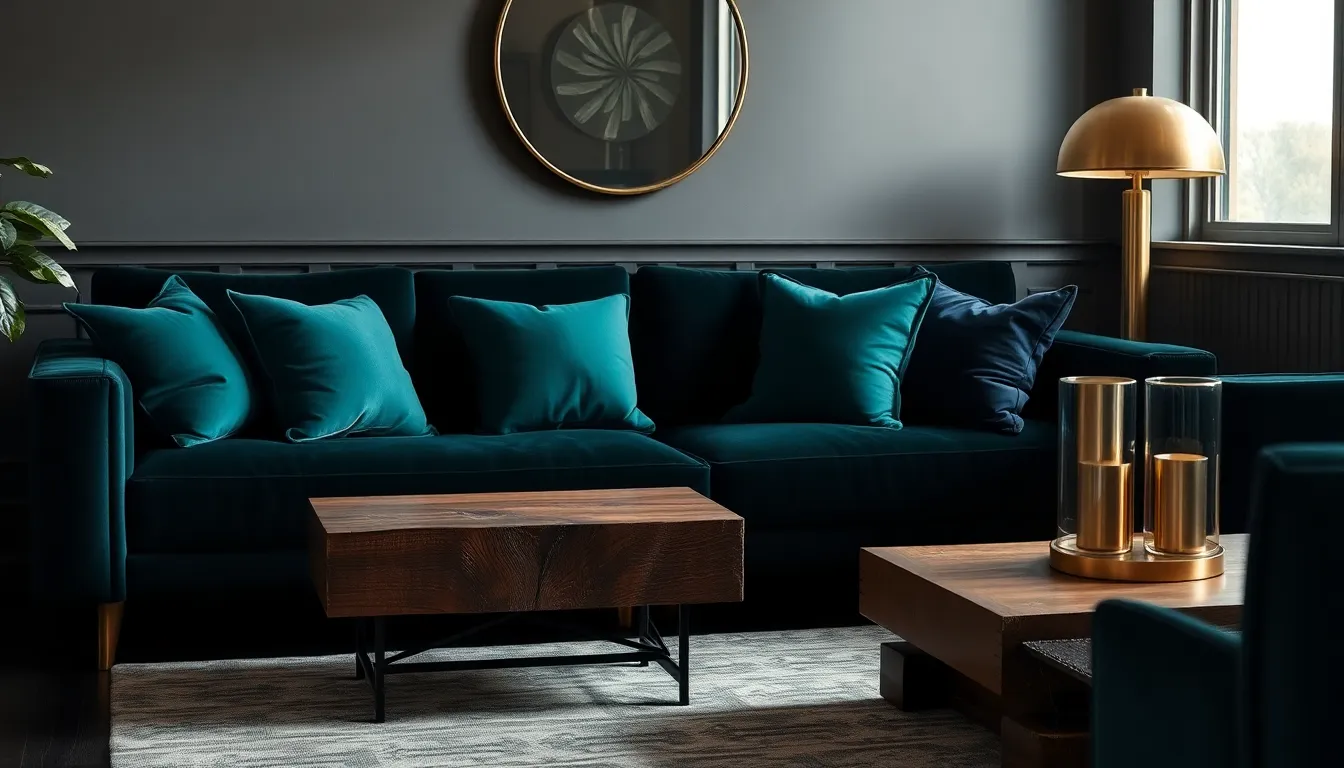
Texture layering transforms dark living spaces into sophisticated sanctuaries with depth and character. We’ll explore three essential texture categories that create stunning visual contrasts in darker room schemes.
Plush Velvet Cushions and Throws
Velvet’s luxurious surface creates an immediate sense of elegance in dark living rooms. We recommend incorporating velvet cushions in deep jewel tones like emerald or sapphire to complement your existing color palette. Throws draped over dark furniture pieces add instant warmth and visual softness to angular surfaces.
Different pile heights in velvet create subtle texture variations that catch light beautifully in darker spaces. Crushed velvet cushions offer more casual appeal while smooth velvet throws provide formal sophistication. We suggest mixing both types across seating areas to create layered interest without overwhelming the space.
Rough Natural Wood Elements
Natural wood brings organic warmth that balances the coolness of dark wall colors. Reclaimed wood coffee tables or floating shelves introduce rustic charm while maintaining the room’s sophisticated edge. We particularly love the contrast between smooth dark walls and weathered wood grain textures.
Live edge furniture pieces serve as stunning focal points in dark living rooms. Wooden ceiling beams add architectural interest overhead while wood accent walls create cozy reading nooks. Consider mixing different wood tones like rich walnut with lighter oak to create depth without adding brightness that competes with your dark color scheme.
Smooth Metallic Accent Pieces
Metallic surfaces reflect light strategically throughout dark living spaces. Brass picture frames and copper table lamps add warm metallic tones that complement deep color palettes perfectly. We recommend limiting metallic finishes to two types maximum to maintain cohesive design flow.
Chrome and silver accents work beautifully with cooler dark tones like charcoal or navy blue walls. Brushed gold hardware on dark cabinetry creates subtle luxury touches that don’t overwhelm the space. Mirror surfaces with metallic frames double the light reflection impact while adding functional storage or display opportunities.
Incorporate Strategic Lighting to Prevent Cave-Like Effects

Strategic lighting transforms dark living rooms from potential cave-like spaces into warm, inviting sanctuaries. Multiple light sources working together create the three-dimensional illumination that makes dark rooms feel spacious and welcoming.
Multiple Light Sources at Different Heights
Creating layers of light at various heights prevents the flat, depressing atmosphere that single overhead fixtures can create. Table lamps positioned on side tables and consoles provide mid-level illumination that softens harsh shadows. Floor lamps placed in corners extend light upward while filling vertical spaces with gentle radiance.
Wall lights frame your living room’s perimeter and highlight architectural edges that might otherwise disappear into darkness. We recommend positioning these fixtures at different elevations to establish visual rhythm throughout the space. Combining these three light levels creates the three-dimensional effect that makes dark rooms feel alive and ever-changing.
Warm-Toned LED Bulbs for Cozy Ambiance
Warm white LED bulbs offer the perfect solution for maintaining a cozy atmosphere without the harshness of cool lighting. These energy-efficient bulbs emit a relaxing glow that complements dark wall colors beautifully. LED technology allows you to achieve consistent warmth across all your fixtures without generating excessive heat.
Choosing bulbs with temperatures between 2700K and 3000K creates the golden undertones that make dark living rooms feel intimate rather than gloomy. We’ve found that warm-toned LEDs enhance the richness of deep jewel tones and metallic accents you’ve already incorporated into your design scheme.
Statement Floor and Table Lamps
Statement lighting fixtures serve dual purposes as both functional illumination and decorative focal points in dark living spaces. Floor lamps with sculptural bases or unique shade designs draw attention while providing essential task lighting for reading or conversation areas. Table lamps featuring interesting textures or metallic finishes reflect light beautifully while adding personality to your room’s design.
Position these statement pieces in areas where natural light is scarce to maximize their impact on overall brightness. We suggest choosing lamps that complement your existing texture palette, such as brass bases that echo your metallic accents or fabric shades that mirror your velvet upholstery.
Choose Dark Paint Colors That Transform Your Space
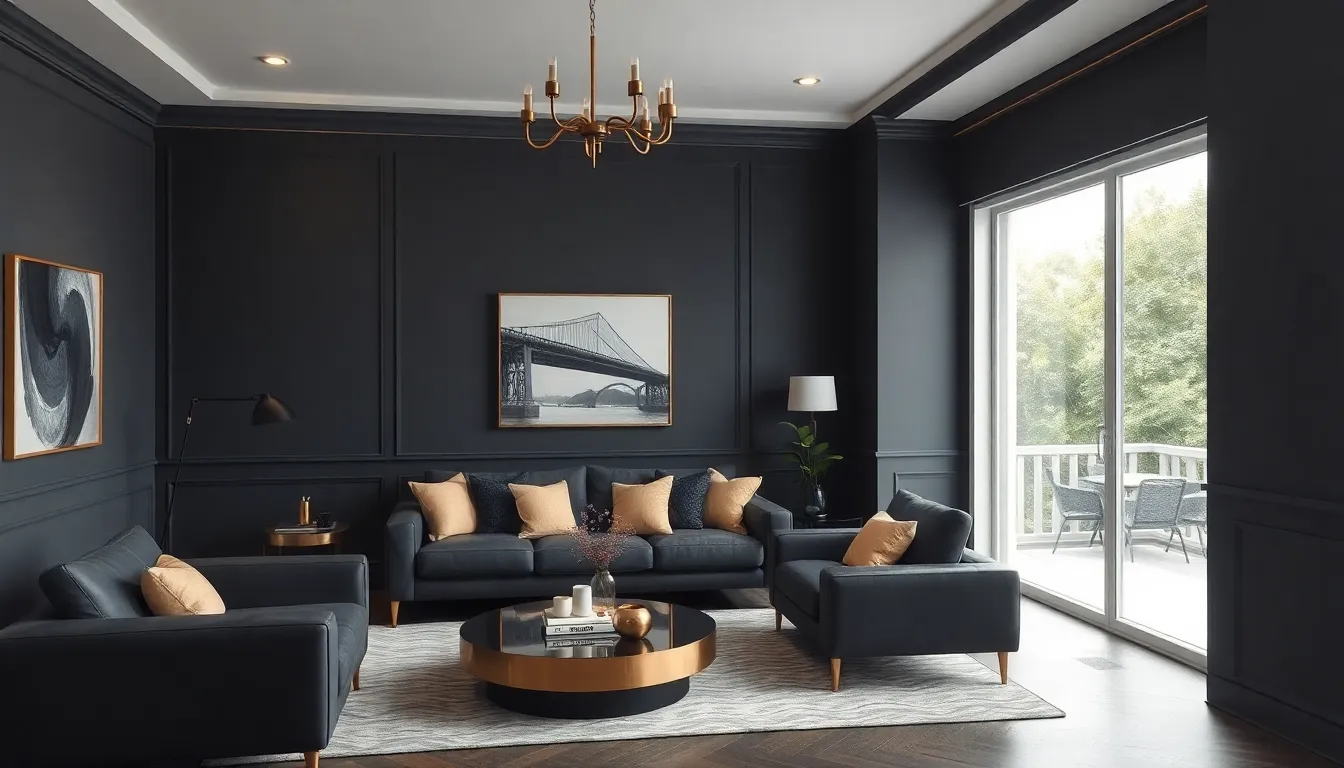
We’ve explored how textures and lighting enhance dark living rooms, but selecting the right paint color remains the foundation of any successful design. Three standout options consistently deliver dramatic results while maintaining sophisticated appeal.
Charcoal Gray for Modern Sophistication
Charcoal gray walls create the perfect backdrop for contemporary luxury living spaces. We recommend pairing this versatile shade with gold accents to achieve an instantly sophisticated atmosphere that feels both modern and timeless. Minimal decor works exceptionally well with charcoal gray, allowing the deep color to make rooms feel calm and inviting rather than overwhelming.
Gold picture frames, brass hardware, and warm metallic lighting fixtures complement charcoal beautifully. Clean lines in furniture and decor enhance the modern aesthetic while preventing visual clutter. We’ve found that this combination works particularly well in living rooms with large windows, where natural light can highlight the subtle variations in the gray tones throughout the day.
Deep Navy Blue for Timeless Elegance
Navy blue walls deliver dramatic impact while maintaining classic elegance that never goes out of style. We especially love incorporating coffered ceilings painted in matching navy to create a color drenched look that exudes pure sophistication. This monochromatic approach wraps the entire room in rich color, making spaces feel intimate and luxurious.
Brass accents and warm wood tones pair beautifully with deep navy walls. White or cream trim provides crisp contrast that prevents the space from feeling too dark. We suggest adding navy blue furniture pieces like velvet sofas or accent chairs to reinforce the color scheme while maintaining visual interest through varied textures and finishes.
Rich Black for Bold Contemporary Style
Black walls make the boldest statement possible while creating strikingly contemporary living spaces. We recommend balancing this dramatic choice with eclectic textiles in vibrant colors or patterns to prevent the room from feeling stark. Industrial accents like exposed brick walls and metal fixtures complement black beautifully, adding texture and visual interest.
Mixed materials become essential when working with black walls. Warm wood furniture, colorful artwork, and metallic accessories help soften the intensity while maintaining the modern edge. We’ve discovered that black works exceptionally well in rooms with plenty of natural light, where the contrast between bright windows and dark walls creates stunning visual drama throughout the space.
Add Metallic Accents to Create Glamorous Contrast
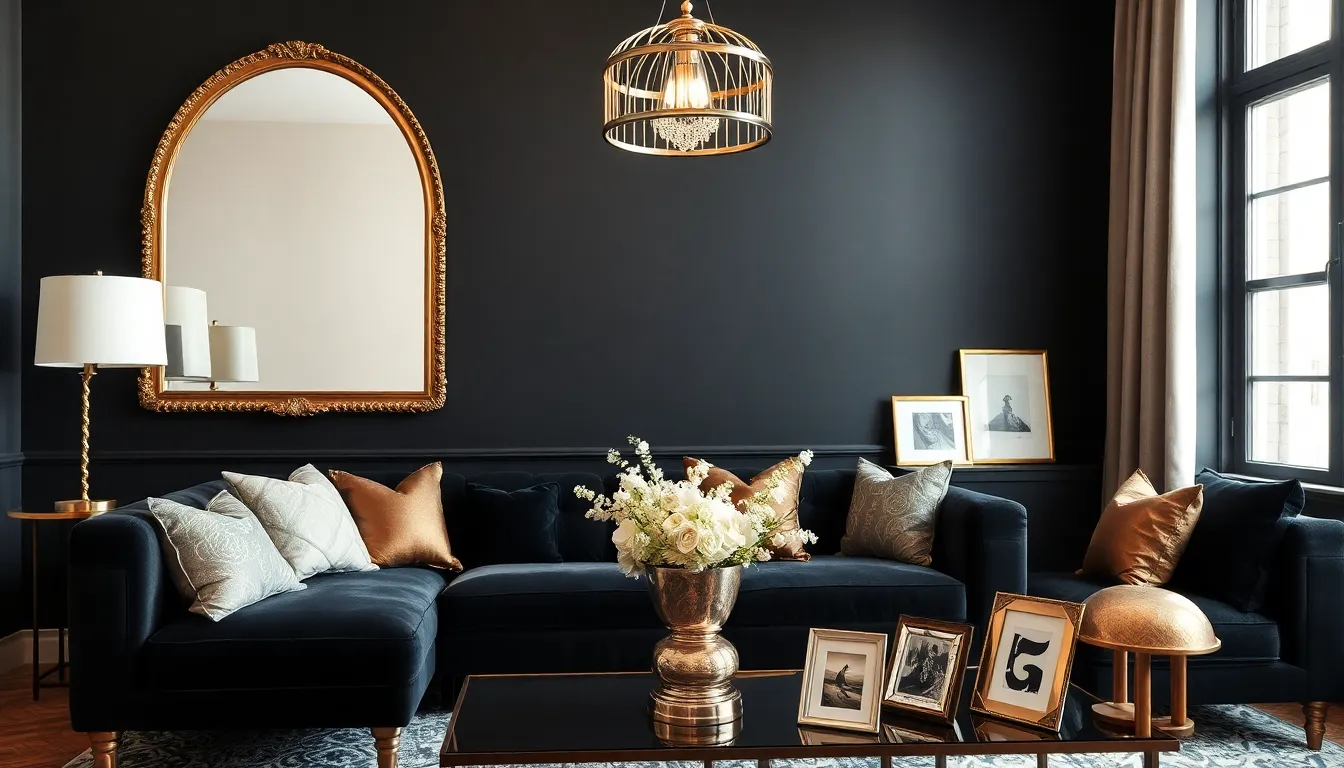
Metallic elements serve as the perfect complement to dark living rooms, adding sophistication while preventing spaces from feeling too heavy. These reflective surfaces catch and bounce light throughout the room, creating visual interest and luxurious depth.
Gold Hardware and Picture Frames
Gold accents transform ordinary dark living rooms into sophisticated spaces with their warm, luxurious appeal. We recommend incorporating gold hardware on furniture pieces like coffee tables, side tables, and entertainment units to create striking visual contrast against charcoal or navy walls. Picture frames in brushed or antique gold finishes add instant elegance while highlighting your favorite artwork or family photos.
Cabinet pulls, drawer handles, and decorative hardware in gold tones provide subtle luxury touches that catch the eye without overwhelming the design. Consider mixing different gold finishes like brushed brass and antique gold to create layered sophistication. Gallery walls featuring gold frames of varying sizes create stunning focal points that draw attention upward and make ceilings appear higher.
Copper Light Fixtures and Accessories
Copper elements bring warmth and industrial chic style to dark living spaces while maintaining sophisticated appeal. Pendant lights with copper shades or exposed copper wiring create ambient lighting that enhances the cozy atmosphere of deep colored walls. We suggest incorporating copper table lamps or floor lamps to add both functional lighting and decorative interest.
Copper accessories like vases, planters, and decorative bowls introduce organic warmth that balances the coolness of dark paint colors. Exposed copper piping or copper accent walls behind entertainment centers create dramatic architectural details. The natural patina that copper develops over time adds character and authenticity to your living room design.
Silver Mirror Frames and Decorative Objects
Silver accents provide modern sophistication and help reflect light throughout dark living rooms. Large mirrors with silver or chrome frames serve dual purposes by expanding visual space and bouncing light off dark surfaces. We recommend positioning silver framed mirrors opposite windows or light sources to maximize their light reflecting benefits.
Decorative objects in polished silver or chrome finishes add contemporary glamour without competing with other metallic elements. Silver picture frames, candlesticks, and sculptural pieces create cohesive styling when grouped on coffee tables or floating shelves. Chrome or stainless steel furniture legs on sofas and chairs introduce subtle metallic touches that maintain the room’s sleek, modern aesthetic.
Select the Right Furniture to Complement Dark Schemes
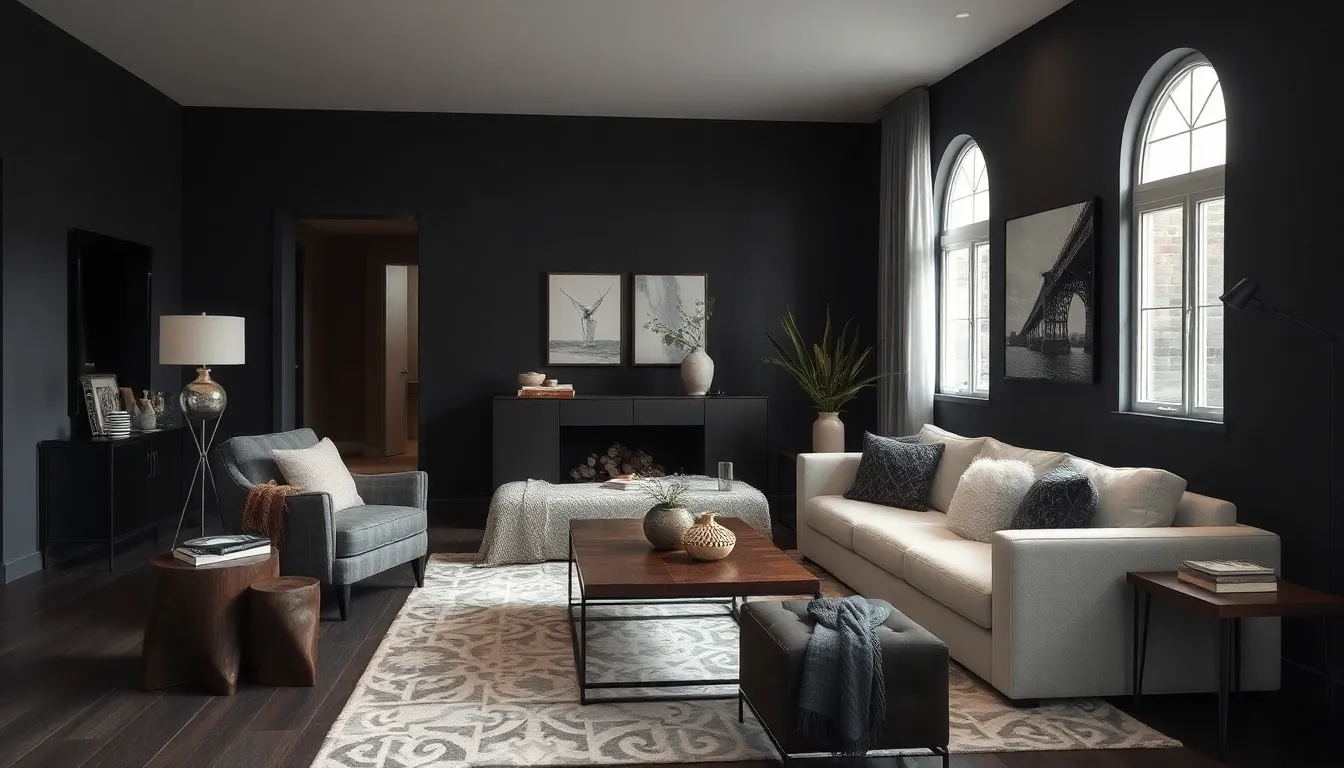
Choosing the right furniture pieces becomes crucial when working with dark color palettes. The key lies in creating visual balance that prevents your space from feeling overwhelming while maintaining that sophisticated atmosphere you’re after.
Light-Colored Sofas for Visual Balance
Light-colored sofas serve as the perfect counterbalance to dark walls and dramatic color schemes. Cream, soft grey, and white upholstery create stunning visual contrast that brightens your seating area and enhances the perception of space. We’ve found that these lighter tones prevent dark rooms from feeling too heavy or closed in, making your living area feel more open and inviting.
Neutral-toned sectionals work particularly well in larger dark living rooms where you need substantial seating without adding visual weight. Soft grey sofas offer versatility that complements both charcoal walls and deep navy schemes. White upholstery creates the most dramatic contrast but requires more maintenance in high-traffic areas.
Dark Wood Coffee Tables and Side Tables
Dark wood coffee tables and side tables blend seamlessly with your established color palette while adding warmth and sophistication. Espresso and deep walnut finishes reinforce the dark aesthetic without competing with your wall colors. These pieces provide solid, grounding elements that anchor your room’s design and create visual continuity.
Coffee tables in rich mahogany tones complement burgundy and emerald color schemes beautifully. Side tables with dark finishes add functional surfaces while maintaining your room’s dramatic atmosphere. We recommend choosing pieces with interesting grain patterns or subtle texture details that catch light and add visual interest.
Mixed Material Pieces for Added Dimension
Mixed material furniture introduces depth and prevents your dark living room from appearing flat or one-dimensional. Combining leather, metal, glass, stone, and textured textiles creates layers that enhance the overall sophistication of your space. A leather sofa paired with a marble-top coffee table and brushed metal side tables demonstrates how different materials work together harmoniously.
Glass accent tables reflect light and create visual breathing room in dark schemes. Stone elements like marble or granite surfaces add luxury while maintaining the dramatic feel. Metal frames in brass, copper, or black finishes tie into your metallic accent strategy while providing structural contrast to soft upholstered pieces.
Use Mirrors and Glass to Maximize Natural Light

Strategic placement of mirrors and glass elements can transform your dark living room from potentially gloomy to brilliantly illuminated. We’ll show you how reflective surfaces work as natural light multipliers in darker spaces.
Large Statement Mirrors on Feature Walls
Positioning large mirrors on feature walls creates instant depth while doubling your available natural light. We recommend placing oversized mirrors directly across from windows to capture and reflect incoming sunlight throughout the room. Floor-to-ceiling mirrors work exceptionally well behind dark sofas or on accent walls painted in deep navy or charcoal gray.
Leaning mirrors against walls adds a casual elegance that complements dark color schemes perfectly. These statement pieces don’t require wall mounting and can be repositioned seasonally to optimize light reflection. Round mirrors measuring 36 inches or larger create striking focal points while softening the angular lines often found in dark living rooms.
Antique or ornate mirror frames enhance the luxurious feel of jewel-toned spaces. Gold-framed mirrors pair beautifully with emerald green accent walls, while silver frames complement sapphire blue furniture pieces. The decorative frames add texture variation that prevents your dark room from feeling too minimalist.
Glass Coffee Tables and Side Tables
Transparent glass coffee tables maintain visual flow while allowing light to pass through unobstructed. We’ve found that glass surfaces prevent dark living rooms from feeling cramped by eliminating visual barriers between seating areas. Tempered glass tables provide durability without sacrificing the light-improving benefits you need.
Acrylic or lucite side tables offer the same transparency benefits with modern appeal. These materials complement metallic accents like brass and copper while maintaining the sleek aesthetic that works well with dark wood furniture. Clear tables also showcase beautiful area rugs underneath without interruption.
Mirrored coffee tables combine reflection with functionality for maximum light distribution. These pieces double as decorative elements while serving practical purposes in your seating arrangement. Mirrored surfaces work particularly well with burgundy velvet upholstery, creating stunning light interplay.
Reflective Surfaces Throughout the Room
Incorporating metallic vases and decorative objects creates multiple light reflection points. We suggest using brass, silver, and copper accessories strategically placed on shelves, mantels, and side tables. These smaller reflective elements work together to bounce light into darker corners of your living space.
Mirrored picture frames and wall art amplify both natural and artificial lighting. Gallery walls featuring mirrors mixed with framed artwork create visual interest while maximizing light reflection. This approach works especially well with warm-toned LED bulbs that enhance the richness of your dark color palette.
Glossy ceramic pottery and glass sculptures serve as both decor and light enhancers. These decorative pieces catch and reflect light from multiple angles, adding sparkle to your sophisticated dark living room. Crystal or glass bowls placed on coffee tables create beautiful light patterns when positioned near windows or table lamps.
Incorporate Plants and Natural Elements for Life
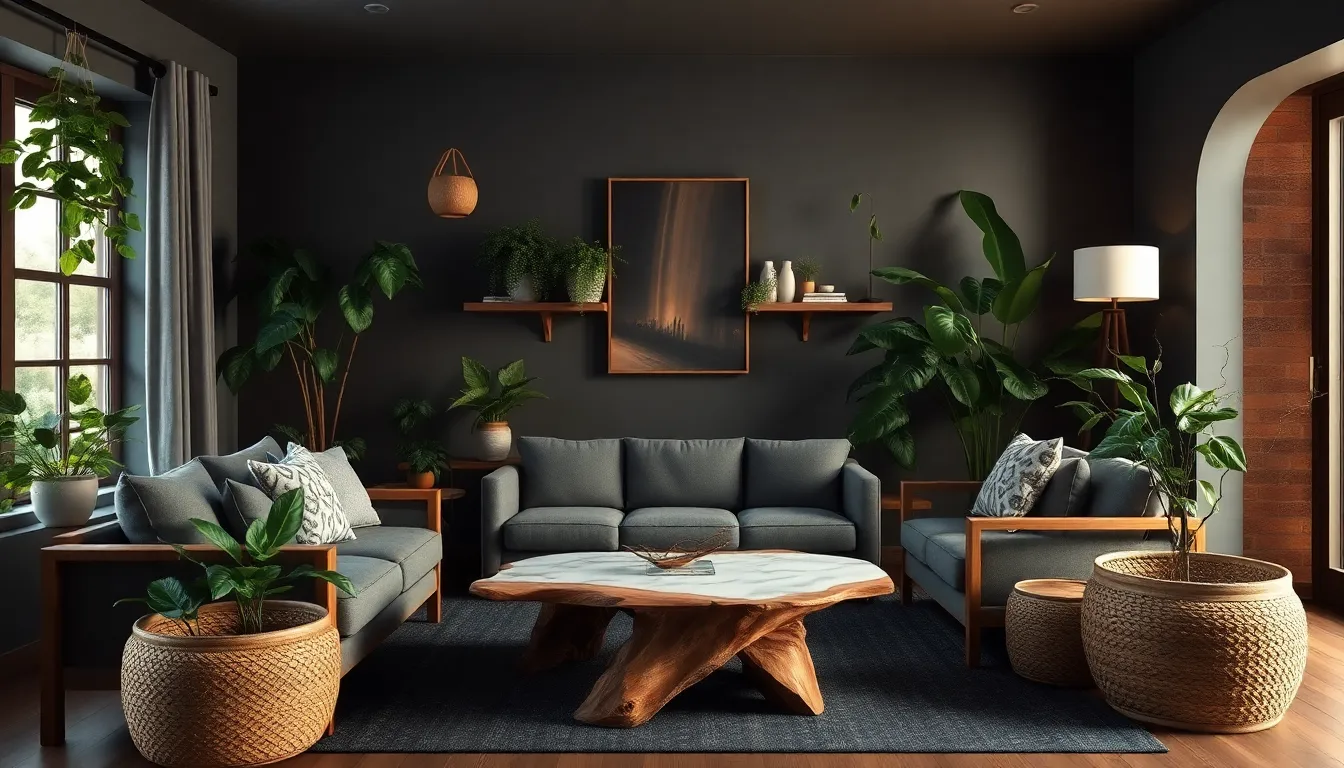
We’ve explored how lighting and textures transform dark living rooms into sophisticated spaces. Now let’s breathe life into these elegant environments by introducing natural elements that thrive in low light conditions.
Low-Light Tolerant Houseplants
Pothos plants offer the perfect solution for dark living rooms, thriving in minimal natural light while cascading beautifully from floating shelves or tall plant stands. These trailing vines create stunning vertical interest against charcoal or navy walls, requiring watering only once the soil feels dry to the touch.
Snake plants stand tall as sculptural elements in dark corners, reaching heights of up to 4 feet while tolerating neglect and low light conditions. Their sword-like leaves with yellow edges provide striking contrast against deep backgrounds, making them ideal for minimalist dark room designs.
Chinese Evergreen plants bring pops of color with their variegated leaves featuring silver, pink, or red patterns that catch available light beautifully. We recommend placing these compact beauties on coffee tables or side tables where their colorful foliage can serve as living artwork.
Natural Wood Furniture and Decor
Wooden beams create dramatic architectural interest when installed as ceiling accents, providing rustic warmth that balances the sophistication of dark walls. This design element works particularly well in rooms with higher ceilings, where the natural wood grain adds texture without overwhelming the space.
Natural finish furniture brings organic warmth to dark living rooms through pieces like live edge coffee tables, reclaimed wood media consoles, and solid oak side tables. We suggest choosing furniture with visible wood grain and warm undertones that complement rather than compete with your dark color scheme.
Woven baskets serve dual purposes as both storage answers and textural elements, providing places to tuck away throws or magazines while adding natural fiber interest. Large floor baskets filled with eucalyptus branches or pampas grass create striking floor displays that don’t require maintenance.
Stone or Marble Accent Pieces
Marble coffee tables introduce sophisticated earthiness through their natural veining patterns, which create visual movement against solid dark backgrounds. We recommend white Carrara or warm Calacatta marble for maximum contrast, or darker stones like black marble for subtle luxury.
Stone accent walls transform ordinary spaces into dramatic focal points, with materials like slate, limestone, or brick providing texture that catches and reflects ambient light. These walls work particularly well behind entertainment centers or as backdrop walls for seating areas.
Natural stone accessories complete the organic element story through pieces like granite bookends, slate coasters, or river rock table lamps that bring geological interest to dark surfaces. These smaller accents allow you to experiment with natural materials without major renovation commitments.
Create Focal Points with Dark Feature Walls

Strategic placement of dark feature walls transforms living rooms into sophisticated spaces with compelling visual anchors. These dramatic elements draw the eye while maintaining the room’s overall balance.
Textured Wallpaper in Dark Patterns
Geometric patterns in dark hues elevate living rooms with modern sophistication and visual intrigue. We recommend selecting wallpapers featuring bold triangles, hexagons, or chevron designs in deep charcoals or midnight blues to create contemporary focal points. Pairing these geometric elements with gold or silver accents amplifies the glamorous appeal while maintaining the room’s dramatic foundation.
Textured wallpaper adds essential depth and layering that prevents dark walls from appearing flat or monotonous. We’ve found that raised patterns, embossed designs, and fabric-textured papers create tactile interest that invites closer inspection. Dark floral wallpapers particularly excel at creating garden-like atmospheres with their rich botanical motifs against deep backgrounds.
Combining textured elements with strategic lighting reveals the wallpaper’s dimensional qualities throughout different times of day. We suggest installing wall sconces or picture lights to graze across textured surfaces, highlighting the intricate patterns and creating ever-changing shadow play.
Painted Accent Walls Behind Seating Areas
Vibrant painted accent walls behind seating areas create striking contrasts that energize dark living room schemes. We’ve discovered that bold jewel tones like emerald green or sapphire blue transform ordinary sofa arrangements into gallery-worthy vignettes. These colorful backdrops make dark furniture pieces appear more refined while establishing clear conversation zones.
Monochromatic accent walls offer sophisticated alternatives for homeowners preferring subtle drama over bold contrasts. We recommend selecting paint colors that are two to three shades deeper than the room’s primary dark tone to maintain harmony while creating definition. Charcoal walls paired with rich black accent panels exemplify this approach beautifully.
Strategic color placement behind seating ensures the accent wall serves as both backdrop and frame for your furniture arrangement. We position these features to highlight architectural elements like built-in shelving or fireplace surrounds, creating cohesive design narratives throughout the space.
Dark Wood Paneling for Rustic Appeal
Dark wood paneling introduces rustic charm that perfectly complements leather furniture and exposed architectural elements. We favor rich walnut or espresso-stained panels that add warmth while maintaining the room’s sophisticated dark palette. Combining these wooden elements with rustic beams creates cabin-like coziness without sacrificing urban elegance.
Industrial metal accents paired with dark wood paneling achieve chic urban aesthetics that feel both rugged and refined. We recommend incorporating brass hardware, steel brackets, or copper fixtures to bridge the gap between rustic wood tones and contemporary design sensibilities. Exposed brick walls alongside dark paneling further enhance this industrial-meets-rustic approach.
Vertical or horizontal paneling orientations dramatically affect room proportions and visual flow. We install vertical panels to emphasize ceiling height in compact spaces, while horizontal applications make narrow rooms appear wider and more expansive.
Balance Dark Elements with Strategic Light Colors

Creating a stunning dark living room requires thoughtful balance between deep hues and lighter accents. We’ve found that incorporating strategic light colors prevents dark spaces from feeling overwhelming while maintaining their sophisticated appeal.
Cream and White Throw Pillows
Cream throw pillows instantly transform dark furniture into inviting seating areas that feel both cozy and refined. We recommend layering different textures like linen, cotton, and faux fur in cream tones across dark sofas and chairs to create visual warmth. White accent pillows provide crisp contrast against charcoal or navy upholstery, making the space feel fresh and balanced. Mixing cream and white pillows in various sizes creates depth while introducing the perfect amount of brightness to counteract heavy dark elements.
Light-Colored Area Rugs
Light colored area rugs serve as anchoring elements that define seating areas while adding essential contrast to dark flooring. We’ve seen how cream, beige, and soft gray rugs create stunning focal points that brighten the entire room from the ground up. Placing a large light rug under your seating arrangement helps establish boundaries and makes the space feel more organized and intentional. Textured light rugs in materials like jute or wool add visual interest while maintaining the sophisticated atmosphere that dark living rooms are known for.
Pale Artwork and Wall Decorations
Pale artwork creates striking focal points that draw the eye and prevent dark walls from feeling too dense or overwhelming. We suggest incorporating soft watercolor paintings, black and white photography with white matting, or abstract pieces in muted tones to add subtle pops of lightness. Gallery walls featuring pale frames and light colored artwork become beautiful conversation starters while breaking up expanses of dark paint. Decorative mirrors with light colored frames serve double duty by reflecting available light and adding pale accents that enhance the room’s overall brightness and visual balance.
Conclusion
We’ve shown you that creating a stunning dark living room isn’t about compromising on comfort or style—it’s about embracing bold design choices that transform your space into a sophisticated sanctuary. By thoughtfully combining deep paint colors with strategic lighting warm textures and carefully chosen accents you’ll achieve a room that feels both dramatic and welcoming.
Remember that balance is key when working with dark tones. We’ve outlined how the right mix of metallic accents reflective surfaces and natural elements can elevate your space from simply dark to genuinely luxurious. Whether you’re working with a compact area or spacious room these design principles will help you create a living space that’s both timeless and uniquely yours.
Your dark living room journey starts with confidence in your vision and ends with a space that truly reflects your personal style.
Frequently Asked Questions
Do dark living rooms make spaces feel smaller?
No, dark living rooms don’t necessarily make spaces feel smaller. When executed properly with strategic lighting, metallic accents, and light-colored furniture, dark colors can actually create depth and sophistication. The key is balancing dark tones with reflective surfaces, mirrors, and varied textures to maintain visual flow and prevent cramped feelings.
What are the best dark paint colors for living rooms?
The top dark paint colors include charcoal gray, deep navy blue, and rich black. Charcoal gray creates modern sophistication, especially with gold accents. Deep navy blue offers timeless elegance, while rich black makes a bold statement that can be softened with warm textures and eclectic decor.
How do you light a dark living room properly?
Use multiple light sources at different heights including table lamps, floor lamps, and wall lights to create three-dimensional illumination. Choose warm-toned LED bulbs to enhance the richness of dark colors. Statement lighting serves as both functional and decorative elements while preventing cave-like feelings.
What furniture works best in dark living rooms?
Light-colored sofas in cream or soft grey create visual balance against dark walls. Dark wood coffee tables add warmth without competing with wall colors. Mixed material furniture combining leather, metal, glass, and stone introduces depth and prevents flat appearances while maintaining sophistication.
Can you use plants in dark living rooms?
Yes, low-light tolerant plants like pothos, snake plants, and Chinese Evergreens thrive in dark spaces. These plants add vibrant color and texture while breathing life into the room. Pair them with natural wood elements and stone accents to create harmony between elegance and liveliness.
How do mirrors help in dark living rooms?
Mirrors maximize natural light by reflecting sunlight and creating depth. Large statement mirrors, leaning mirrors, and round mirrors serve as elegant focal points. Glass coffee tables and reflective surfaces like metallic vases amplify light throughout the room, transforming dark spaces into brilliantly illuminated areas.
What are jewel tones and how do they work in dark rooms?
Jewel tones are rich, deep colors like emerald green, sapphire blue, and burgundy that add sophistication and drama. They create stunning focal points on accent walls, transform ordinary furniture into elegant pieces, and work beautifully with complementary colors and textures for stylish, inviting spaces.
How do you prevent dark living rooms from feeling gloomy?
Balance dark elements with strategic light colors like cream throw pillows, light-colored area rugs, and pale artwork. Layer different textures, incorporate metallic accents, use multiple lighting sources, and add reflective surfaces. Natural elements and plants also help create warmth and prevent overwhelming darkness.







